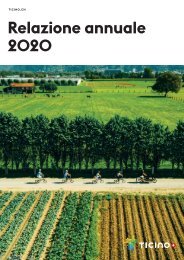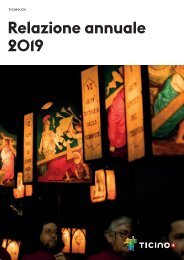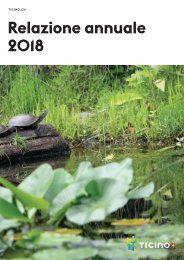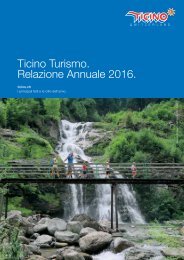#ticinomoments 2019
You also want an ePaper? Increase the reach of your titles
YUMPU automatically turns print PDFs into web optimized ePapers that Google loves.
34 <strong>#ticinomoments</strong><br />
Katrin Lange you have<br />
been managing the Casa<br />
del Tè here on Mount<br />
Verità. What is it?<br />
The Casa del Tè is a cultural<br />
centre where we explain the<br />
history of this drink, organise<br />
events and exhibitions,<br />
but it is also a shop where<br />
you can find many varieties<br />
of special and classic teas<br />
or even chocolate, digestives<br />
and tea-flavoured ice cream<br />
produced in the region.<br />
Lastly, you can come here<br />
simply to enjoy a cup of tea<br />
and read a book.<br />
When was the Casa del<br />
Tè created and your<br />
passion for this drink<br />
born?<br />
The first plants were<br />
brought here to Mount<br />
Verità from the Brissago<br />
Islands. Here there is a<br />
particular microclimate<br />
in which these plants<br />
can grow. In 2006, Peter<br />
Oppliger, a great plant<br />
expert, created this Casa<br />
del Tè focusing mainly on<br />
green tea. We (Katrin, her<br />
husband Gerhard and other<br />
helpers) have expanded the<br />
range. We were able to do<br />
that partially because of the<br />
experience we had accumulated<br />
over the last 40<br />
years in Bern. At that time,<br />
we wanted to change our<br />
lives, we all liked tea and we<br />
asked ourselves: “Why don't<br />
we do it as a job?” So, we<br />
founded Länggass-Tee (from<br />
the name of a well-known<br />
district in Bern), an initiative<br />
that revolves around the<br />
world of tea, ranging from<br />
cultural and meditative<br />
activities to catering and<br />
the sale of tea from every<br />
part of the world, including<br />
seminars and courses for tea<br />
tasters. Since January 2017,<br />
we have been here in Ascona<br />
managing the Casa del Tè: a<br />
new challenge.<br />
But how many different<br />
types of tea are there?<br />
Hundreds. It's a bit like<br />
wine: there are younger teas<br />
and others that are more<br />
seasoned, more aromatic or<br />
tastier. But there are just 6<br />
big tea families… and only<br />
01<br />
one tea plant.<br />
What do you mean?<br />
The tea plant is called<br />
Camellia sinensis (a relative<br />
of the camellias that are<br />
so admired in the Ascona-<br />
Locarno region). From that<br />
same plant come green,<br />
black, white, yellow, oolong<br />
and Pu Er (a fermented<br />
variety) teas. To produce<br />
different types of tea you<br />
have to vary the process,<br />
but the basic ingredient<br />
remains unchanged. It's like<br />
potatoes: using the same<br />
tuber you can make gnocchi,<br />
rösti, salad, French fries<br />
and much more.<br />
Here on Mount Verità<br />
there is also the only tea<br />
plantation on the European<br />
continent. How<br />
much can you produce?<br />
Here we have about 1,400<br />
plants and we produce<br />
about 3 kg of tea in a year's<br />
work! This is a demonstration<br />
plantation to show how<br />
tea is produced. Every year,<br />
on the Ascension weekend,<br />
we organise an event dedicated<br />
to the harvesting and<br />
production of tea. Specialists<br />
come here from Asia<br />
and it's a party.<br />
The Japanese tea ceremony<br />
is another special<br />
event. You regularly<br />
offer an opportunity<br />
to join it. What does it<br />
involve?<br />
It's an art form. In the Japanese<br />
tea ceremony, the ideal<br />
moment of being is created,<br />
according to Buddhist rules.<br />
At first, it seems impenetrable<br />
and very rigid. It has<br />
many rules, but it is considered<br />
to be one of the most<br />
elaborate ways to welcome<br />
a guest. The tea ceremony is<br />
part of the Tea Path and you<br />
have to study for years to do<br />
it right.<br />
Are the Zen garden and<br />
the small pagoda in the<br />
plantation also a part of<br />
this art?<br />
Of course: the sand in the<br />
Zen garden is raked every<br />
morning to mark the<br />
concept of “Here and Now”:<br />
what was there yesterday<br />
and what will be there tomorrow<br />
doesn't matter, you<br />
have to live for the moment.<br />
Also, in the Zen gardens<br />
there are stones that play an<br />
important role: they come<br />
from the Brissago Islands<br />
and mark the link with<br />
Mount Verità, two places of<br />
strength.<br />
One last question: what<br />
is the main difference<br />
between tea as it is<br />
drunk in China and in<br />
Japan?<br />
If you go to Japan for two<br />
weeks, you may never see a<br />
tea ceremony, because it's<br />
a private event, difficult to<br />
access. In China, instead,<br />
you will be offered tea by the<br />
first taxi driver you meet at<br />
the airport. But tea always<br />
represents hospitality and<br />
welcome, in China, Japan,<br />
Bern or Ticino.


















